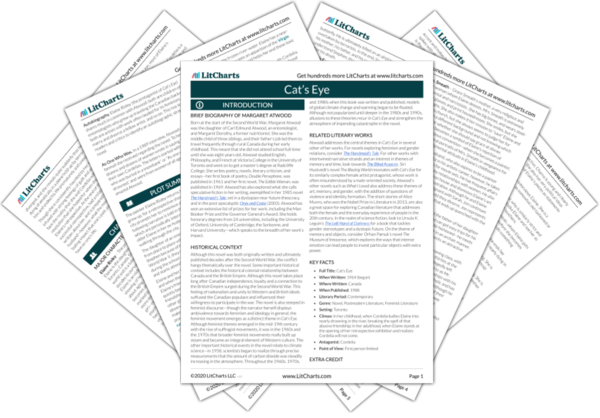Welcome to the LitCharts study guide on Margaret Atwood's Cat’s Eye. Created by the original team behind SparkNotes, LitCharts are the world's best literature guides.
Cat’s Eye: Introduction
Cat’s Eye: Plot Summary
Cat’s Eye: Detailed Summary & Analysis
Cat’s Eye: Themes
Cat’s Eye: Quotes
Cat’s Eye: Characters
Cat’s Eye: Symbols
Cat’s Eye: Theme Wheel
Brief Biography of Margaret Atwood

Historical Context of Cat’s Eye
Other Books Related to Cat’s Eye
- Full Title: Cat’s Eye
- When Written: 1964 (begun)
- Where Written: Canada
- When Published: 1988
- Literary Period: Contemporary
- Genre: Novel, Postmodern Literature, Feminist Literature
- Setting: Toronto
- Climax: In her childhood, when Cordelia bullies Elaine into nearly drowning in the river, breaking the spell of that abusive friendship; in her adulthood, when Elaine stands at the opening of her retrospective exhibition and realizes Cordelia will not come.
- Antagonist: Cordelia
- Point of View: First person limited
Extra Credit for Cat’s Eye
Autobiography. Elaine Risley (the protagonist of Cat’s Eye) shares much in common with Atwood: both are children of entomologists who grew up traveling the Canadian backwoods, both are artists with work often lauded for its feminism, both marry and divorce a fellow artist, and so on. This has led some readers and critics to identify an autobiographic strain in the novel.
As One Who Was. In a 1989 interview, Atwood discussed fanmail she received regarding the novel. To her surprise, dozens and dozens of women wrote in saying that they had had their own Cordelias. The letters started with lines like “As one who was buried in a snowbank” or “As one who was almost drowned,” and were from women of all ages, which really amazed Atwood.







